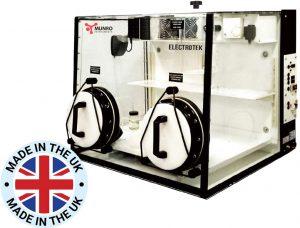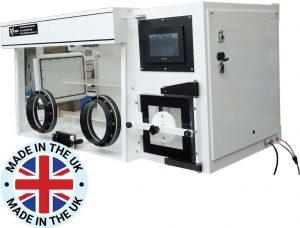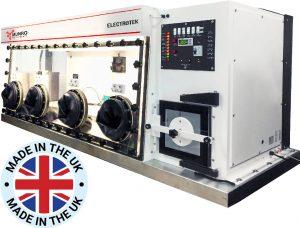About Anaerobic Chamber
An anaerobic chamber is a sealed enclosure designed to create and maintain anaerobic conditions. Anaerobic conditions refer to environments devoid of oxygen or with very low oxygen levels. This controlled atmosphere is essential for various biological and chemical processes that require the absence of oxygen. The primary purpose of anaerobic chambers is to create an environment where oxygen-sensitive experiments can be conducted. This includes cultivating anaerobic bacteria, performing anaerobic assays, and conducting experiments on oxygen-sensitive compounds.
Anaerobic Conditions
Anaerobic conditions are necessary for the growth and study of anaerobic microorganisms, which cannot survive in the presence of oxygen. These organisms important roles in processes such as fermentation and nitrogen fixation.
Components of Anaerobic Chambers-General
Anaerobic chambers consist of several components that work together to create and maintain anaerobic conditions.
Glove Ports
Glove ports are openings in the chamber walls that allow researchers to manipulate samples and equipment inside the chamber without exposing them to outside air.
Gas Inlet and Outlet Systems
Anaerobic chambers are equipped with gas inlet and outlet systems that control the composition of the atmosphere inside the chamber. Typically, a mixture of gases such as nitrogen, hydrogen, and carbon dioxide is used to create an oxygen-free environment.
Oxygen Sensors
Oxygen sensors continuously monitor the oxygen levels inside the chamber, ensuring that they remain within the desired range. If oxygen levels rise above the set threshold, the chamber’s gas supply is adjusted accordingly to restore anaerobic conditions.
Temperature and Humidity Control
Maintaining stable temperature and humidity levels is essential for creating optimal conditions inside the anaerobic chamber. Most chambers are equipped with heating and cooling systems, as well as humidity control mechanisms.

Applications of Anaerobic Chambers
Anaerobic Workstations find applications across various scientific disciplines and industries.
Microbiology Research
Used to culture and study anaerobic bacteria, archaea, and other microorganisms. They are indispensable tools for investigating microbial physiology, ecology, and evolution.
Clinical Diagnostics
Anaerobic chambers are employed in clinical laboratories for culturing anaerobic pathogens responsible for infections such as gangrene, tetanus, and bacterial vaginosis. They facilitate the isolation and identification of anaerobic bacteria from clinical samples.
Industrial Applications
In industries such as food and beverage, pharmaceuticals, and biotechnology, They are utilized for various purposes, including fermentation, anaerobic digestion, and the production of anaerobic metabolites.

Benefits of Using Anaerobic Chambers
The use of anaerobic chambers offers several advantages for researchers and industries alike.
Protection of Anaerobic Organisms
Anaerobic chambers provide a safe and controlled environment for cultivating anaerobic organisms, protecting them from exposure to oxygen, which can be toxic or lethal to them.
Prevention of Oxidation
By eliminating oxygen from the environment, they prevent oxidation reactions that can degrade sensitive compounds or interfere with biochemical processes.
Enhanced Experimental Control
They allow researchers to precisely control experimental conditions, including temperature, humidity, and gas composition, ensuring reproducibility and accuracy in their experiments.
Setting Up an Anaerobic Chamber
Setting up an anaerobic chamber requires careful consideration of various factors to ensure optimal performance and safety.
Installation Requirements
Anaerobic chambers should be installed in a well-ventilated area with access to gas supplies and electrical outlets. Proper ventilation is essential to prevent the buildup of potentially hazardous gases inside the chamber.
Maintenance of Anaerobic Chambers
Regular maintenance is crucial for ensuring the proper functioning of anaerobic chambers and prolonging their lifespan.
Cleaning Procedures
Anaerobic chambers should be cleaned regularly to remove dust, contaminants, and microbial residues that can compromise experimental results. Cleaning protocols may vary depending on the chamber’s design and materials.
Calibration of Sensors
Oxygen sensors and other monitoring devices should be calibrated periodically to ensure accurate readings. Calibration procedures should be performed according to manufacturer instructions using calibrated standards.
Gas Supply Management
Proper management of gas supplies is essential for maintaining anaerobic conditions inside the chamber. Gas cylinders should be securely stored and replaced as needed to prevent interruptions in gas flow.


